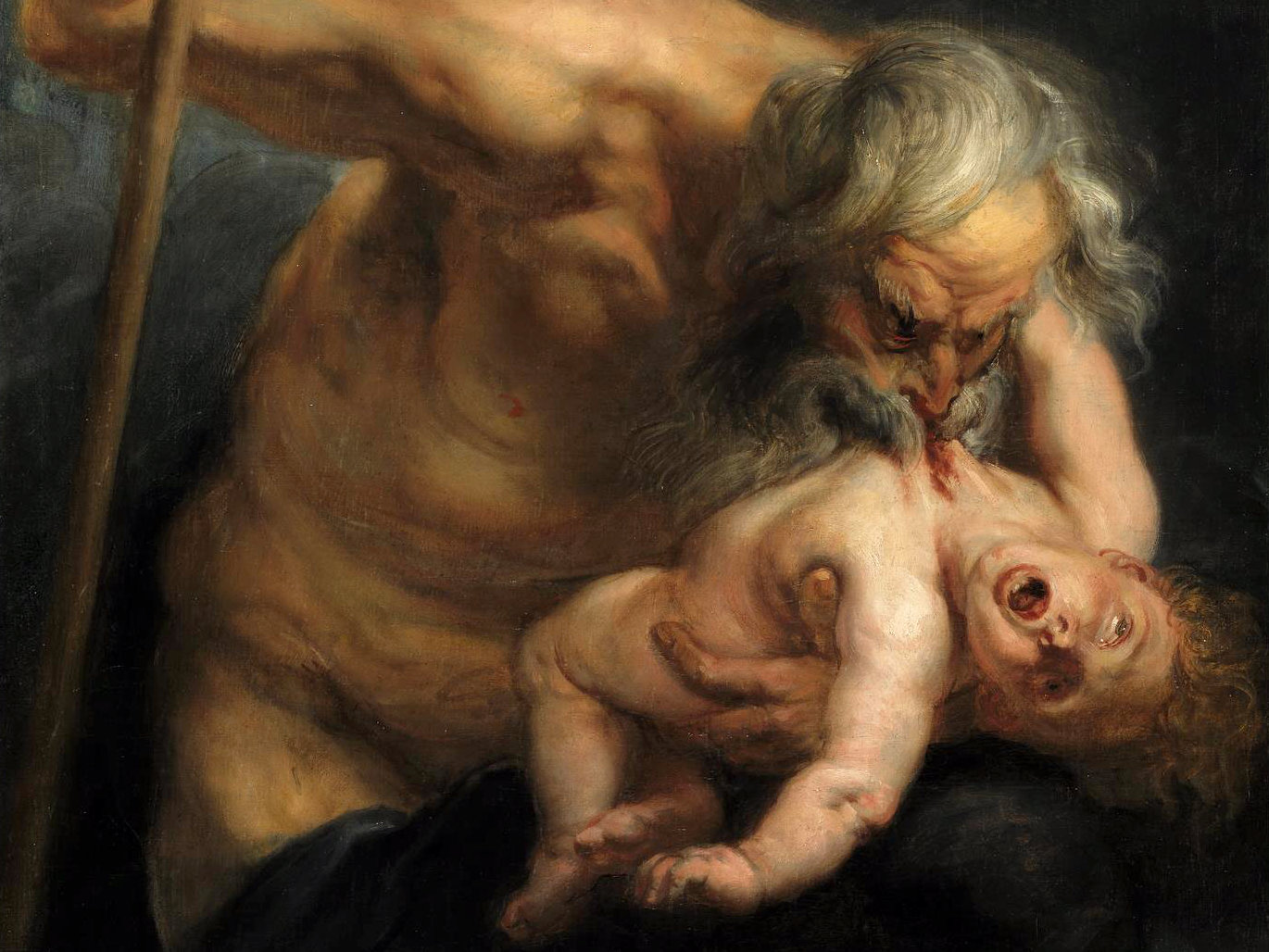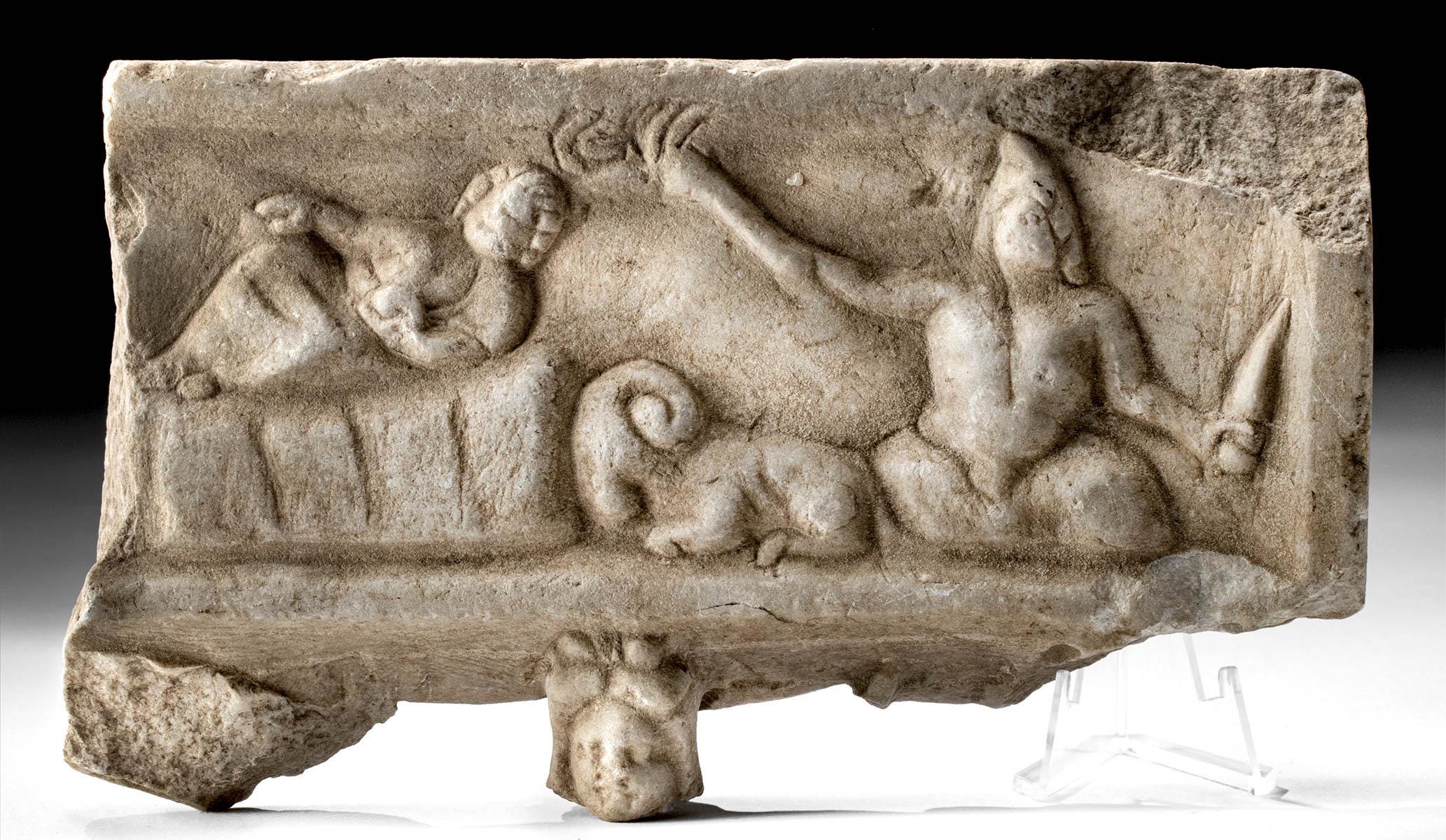The Father of Mithras

Saturn by Rubens
Public domain
Attilio Mastrocinque is one of the scholars who has given the most thought to the legend of Mithras. In particular, the Venetian author has tried to make sense of the series of pradellas that sometimes frame the Tauroctony or other important scenes, especially from the Rhine area or from some Roman frescoes[1].
Among the many vignettes, we find a pair that could explain not only the earthly birth of Mithras, but also his astonishing conception thanks to his father’s wet dreams.
But let’s take it one step at a time. Mithras is known as a primeval god who rules the cosmos and therefore the fate of each and every one of us. Yet we know that part of his existence takes place on earth, in the golden age of mankind, in the form of a handsome young man dressed in oriental garb. And it is here, on our little blue planet, that the Roman Mithras performs a series of portents, culminating in the Tauroctony, followed by the Dinner and the subsequent ascent back to the world of the gods.
In order to justify this ubiquity, and in particular his advent on the material plane, the artists of Imperial Rome strove to depict the birth of Mithras out of a rock, an episode known as the petrogenia. In such monuments we see the solar god, younger than usual, naked except for his inseparable Phrygian cap, emerging from the rock generatrix with his arms raised, holding a dagger and a torch in his hands.
This event is usually preceded in retablos by the image of a well-built adult, also naked, but in this case lying down, apparently asleep. This enigmatic figure is none other than Saturn-Chronos, who, as we know, plays an important role in the mysteries of Mithras as the protector of the patres of the Mithraic communities, as well as giving his name to the most distant planet in the ancient solar system and last station in the ascent of souls during the process of reincarnation, as explained by Origen of Alexandria[2].
Cumont, as usual, tried to relate the Chronos-Saturn of the Mithraic retablos to the Mesopotamian tradition and ventured that it could be the same god who revealed the universal flood in a dream to Ziusudra, the Sumerian Noah[3]. Vermaseren interpreted the scene as the moment when Chronos, in a dream, tells the attentive ear of Jupiter how to create the world[4]. Merkelbach suggested that such a scene might represent the instructions given by Saturn to the Mithraic patres in their dreams to lead their respective communities[5]. The latter author also proposed that it was in dreams that Saturn learned of the need to beget a saviour god from a rock.
In any case, Saturn’s dreams are known from various sources, including treatise 10 of the Corpus Hermeticum[6]. We also have other Indo-European and paradigmatic examples of dreams of gods with performative power. Saturn’s little naps, during which he reveals the laws of the universe to those who pass by, remind us of the Hindu Vishnu, who creates the world simply by dreaming about it, as revealed in the Puranas dedicated to the same god.

Anonymous / Creative Commons
To return to Mithras, the birth of gods and their relatives out of a rock or mountain is well known in Asia Minor. After all, both humans and gods who venture into these parts are still stardust. And from dust to dust, as the Christians say.
As for Mithraism, we have the following passage from Pseudo-Plutarch, which is instructive both for what it says and for what it implies:
Near to this river lies the mountain Diorphus, so called from Diorphus, the son of the earth, of whom this story is told. Mithras, desirous to have a son, yet hating woman-kind, lay with a stone, till he heated it to that degree that the stone grew large, and at the prefixed time was delivered of a son, called Diorphus; who, growing up and contending with Mars for courage and stoutness, was by him slain, and by the providence of the gods was transformed into the mountain which was called Diorphus by his name.
Walter Burkert shows us that this passage has its origins in the Hittite myth of Ullikummi, in which Kumarbi impregnates a rock from which Ullikummi, a diorite giant, is born[9]. According to Robert Turcan and Mastrocinque himself, the Mesopotamian sun god Shamash was depicted, along with other Anatolian gods, rising from a mountain[10].
The Greek Ephesios, aroused by the goddess Athena despite her repudiation, ejaculated on the earth and Gaia gave birth to Erichthonios, the first king of Athens. In fact, Saint Jerome compared the birth of Mithras to that of Erichthonios, since both were born “from a rock or from the earth fertilised by an excess of libido”[11].
An excess of libido, of desire, of vigour, of power in short, like that of the fearsome Shiva, who, during his deep meditation, also conceives one of his sons without a woman, but through the timely intrusion of Kama, the Hindu god of desire. Shiva ejaculates his semen and it is Agni, the god of fire, who swallows it and then spits it out on mother Ganga, who impregnates it and gives birth to Skanda[12].
The conception of Mithras through the dream of Saturn-Chronos can be explained by the doctrine of Plato who, in a passage of the Symposium, describes how the contemplation of beauty provokes ejaculation, the source of all life[13]. The Corpus Hermeticum also reveals that Chronos, in a dream, conceived the most beautiful of all visions.
Saturn, the most distant sphere from the Earth and closest to the hypercosmic world, was therefore considered to be best informed about the sublime world. This is the main reason why the magi valued his prophecies above those of any other god.

Photograph by Louise Laffon / Public domain
In any case, the vision of hypercosmic beauty would be the reason for Saturn’s prolific spurt of semen on the fertile rock that gave earthly life to Mithras. The relief of the birth of Mithras in the third Mithraeum of Ptuj, in which the young Mithras emerges from the rock while Saturn certainly dreams of Victory flying above him, is revealing.
Victory, whose mere image is capable of carrying the Titan of Time and Abundance back to the seventh heaven. A goddess who has every reason to represent the absolute beauty of a solar cult of the Invincible God.
References
- Attilio Mastrocinque (2017) The Mysteries of Mithras. A different account ↑
- Origen (c. 248) Contra Celsum ↑
- Franz Cumont (1930) La fin du monde selon les mages occidentaux. Revue de l’histoire des religions ↑
- Maarten Jozef Vermaseren (1982) Mithriaca III. The Mithraeum at Marino ↑
- Reinhold Merkelbach (1994) Mithras. Ein persisch-römischer Mysterienkult ↑
- Corpus hermeticum ↑
- विष्णुपुराण ↑
- Pseudo Plutarco. De fluviorum ↑
- Walter Burkert (1979) Von Ullikummi zum Kaukasus. Würzburger Jahrbücher ↑
- Robert Turcan (2000) Mithra Tauroctone. Recherches mithriaques ↑
- Eusebius Sophronius Hieronymus (c. 380) Adversus Iovinianum ↑
- स्कन्दपुराणम् ↑
- Πλάτων (c. 385 BCE) Συμπόσιον ↑

Comments
Add a comment